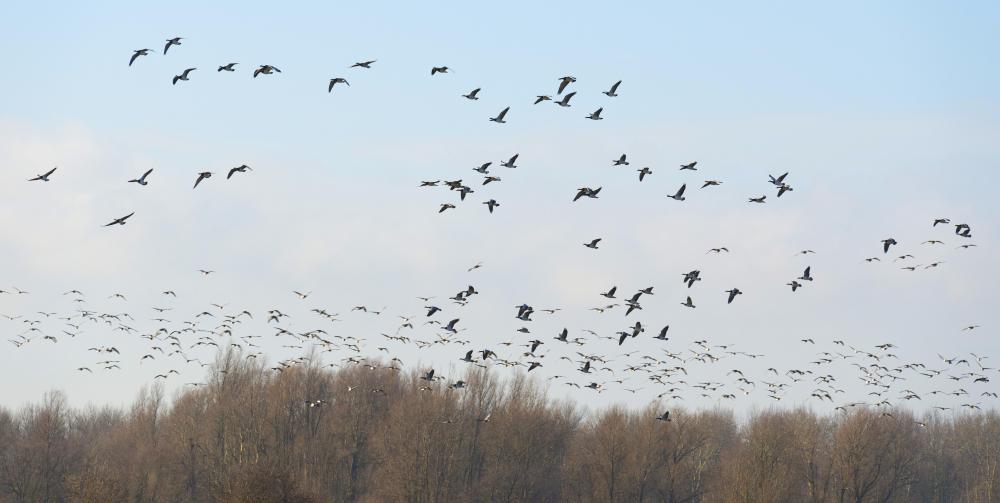At AllThingsNature, we're committed to delivering accurate, trustworthy information. Our expert-authored content is rigorously fact-checked and sourced from credible authorities. Discover how we uphold the highest standards in providing you with reliable knowledge.
What is a Greylag Goose?
A greylag goose is a large goose native to Europe and Western Asia. This type of goose is thought to be the primary ancestor of most domestic geese breeds. The greylag goose is grey-brown on its back, with grey plumage on its neck and a white underbelly. Its scientific name is Anser anser, and it is part of the large family Anatidae that includes geese, ducks, and swans. An alternate spelling used predominantly in the United States is "graylag."
The habitat of the greylag goose includes the US, Western Siberia, Asia, parts of China, Iceland, the British Isles, and Northern and Southern Europe. In the United States, there are both wild and domestic flocks, though the birds native range is restricted to Asia and Europe.

This type of goose is a migratory bird that moves south and to the west in the winter. In mild climates, such as the British Isles, there are wild flocks that stay year-round. The "lag" portion of the name greylag goose is derived from its habit of being one of the last of the migratory geese to move south in the winter.
Greylag geese have a wingspread of about 30 to 35 inches (76 to 89 cm) and are about 31 inches (80 cm) inches long. Mature birds weigh 6 to 8 pounds (about 2.7 to 3.6 kg), and males are often larger than females. The greylag generally is considered the largest of the Anser anser species.

Greylag geese are herbivores and granivores, feeding on shoots, pond plants, roots, tubers, nuts, fruits and grains. This type of goose also favors domestic crops, such as potatoes, carrots, and turnips. These geese can often be found grazing across fields.
The greylag goose builds shallow nests on the ground in marshy areas among reeds, in hollow areas, at the base of trees, and in the underbrush. The nests are built out of reeds, brush, and other plant materials. The greylag goose tends to build nests in wetlands, around ponds and lakes and on small islands.
The females lay between three and 12 pale white eggs in the spring, with an incubation time that ranges from 27 to 29 days. Once out of the egg, the goslings are taken care of and taught to feed themselves by the parents for about eight weeks. After eight weeks, young greylag geese are independent. The birds are relatively solitary during the breeding season, with nests scattered around an area usually at least 36 feet apart. In the late summer and early fall when the birds are molting and preparing for migration, large flocks of up to 25,000 birds come together.
Frequently Asked Questions
What is a Greylag Goose?
The Greylag Goose is a large species of wild goose native to Europe and Asia, with the scientific name Anser anser. It is recognized by its grey feathers, pink legs, and orange or pink bill. This bird is the ancestor of most domestic geese and is known for its loud, honking call and strong migratory habits.
Where can you typically find Greylag Geese?
Greylag Geese are commonly found in temperate regions of Europe and Asia. They prefer wetlands, marshes, and agricultural fields near water bodies. During winter, they migrate south to warmer areas, and according to the Royal Society for the Protection of Birds (RSPB), they can be seen in large flocks in the UK and other parts of Western Europe.
What do Greylag Geese eat?
Greylag Geese are herbivores with a diet consisting mainly of grasses, roots, seeds, and aquatic plants. They graze in fields and meadows and may also feed on crops, which sometimes leads to conflicts with farmers. During the breeding season, they may also consume small insects and invertebrates to gain additional nutrients.
How do Greylag Geese behave during breeding season?
During the breeding season, Greylag Geese form monogamous pairs and are known for their strong pair bonds. They build large nests on the ground near water, using vegetation and down feathers. The female lays 4-6 eggs, and both parents are involved in rearing the goslings. The geese are very protective of their nesting sites.
Are Greylag Geese protected or endangered?
Greylag Geese are not currently considered endangered. They are listed as "Least Concern" on the International Union for Conservation of Nature (IUCN) Red List. However, they are protected under various wildlife conservation acts and migratory bird treaties, which regulate hunting and habitat preservation to ensure their populations remain stable.
What is the significance of Greylag Geese in culture?
Greylag Geese hold a significant place in culture and history. They have been domesticated for thousands of years, providing meat, feathers, and eggs. In folklore, they are often associated with watchfulness and loyalty. The famous "Mother Goose" character from nursery rhymes is believed to be based on the Greylag Goose due to its strong maternal instincts.
AS FEATURED ON:
AS FEATURED ON:












Discuss this Article
Post your comments